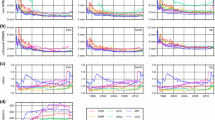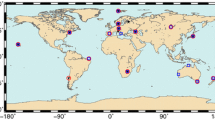Abstract
The International GNSS Service (IGS) routinely generates a number of weekly, daily and sub-daily products. Station coordinates and velocities, earth rotation parameters (ERPs) and apparent geocenter are among these products generated weekly by the IGS Reference Frame Coordinator. They have been determined since 1999 by combining independent estimates from at least seven IGS Analysis Centers (ACs). Two Global Network Associate Analysis Centers (GNAACs) also provide independent combinations using the same AC weekly solutions and they are currently used to quality control the IGS combination. The combined solutions are aligned to an IGS realization (IGS05) of the ITRF2005 using a carefully selected set of the IGS Reference Frame (RF) stations (nominally 132). During the combination process, the contributing solutions are compared and outliers are removed to ensure a high level of consistency of the estimated parameters. The ACs and the weekly combined solution are consistent at the 1–2 and 3–4 mm levels for the horizontal and vertical components. Similarly, the excess Length of Day (LOD), the pole positions and pole rates are consistent at the 10μs, 0.03–0.05 mas and 0.10–0.20 mas/day levels, respectively. The consistency of the apparent geocenter estimate is about 5 mm in the X and Y components and 10 mm in the Z component. Comparison of the IGS-combined ERP estimates with the IERS Bulletin A suggests a small bias of the order of −0.04 mas and + 0.05 mas (both ±0.05 mas) in the x and y components.
Similar content being viewed by others
References
Altamimi Z, Collilieux X, Legrand J, Garayt B, Boucher C (2007) ITRF2005: A new release of the International Terrestrial Reference Frame based on time series of station positions and Earth Orientation Parameters. J Geophys Res 112: B09401. doi:10.1029/2007JB004949
Blewitt G, Boucher C, Kouba J (1997) Procedure for ITRF continuous realization, the report of the IGS GB, presented to the IGS Governing Board Meeting held in San Francisco, Dec. 11
Ferland R (2006) Proposed IGS05 Realization, in IGS Mail. http://www.igs.org/mail/igsmail/2006/msg00170.html
Kouba J, Ray J, Watkins MM, IGS Reference Frame Realization (1998) IGS Analysis Center Workshop Proceedings, European Space Operations Centre, Darmstadt, Germany
Mireault Y, Kouba J, Ray J (1999) IGS earth rotation parameters. GPS Solut 3(1): 50–72
Author information
Authors and Affiliations
Corresponding author
Rights and permissions
About this article
Cite this article
Ferland, R., Piraszewski, M. The IGS-combined station coordinates, earth rotation parameters and apparent geocenter. J Geod 83, 385–392 (2009). https://doi.org/10.1007/s00190-008-0295-9
Received:
Accepted:
Published:
Issue Date:
DOI: https://doi.org/10.1007/s00190-008-0295-9




